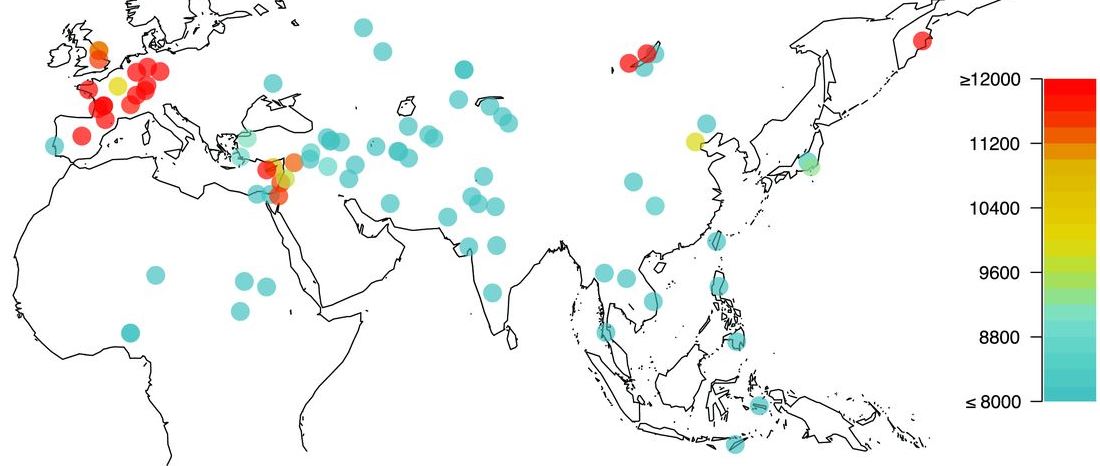Dogs were first domesticated from separate wolf populations that existed in the east and west of the Eurasian continent, a new study has found. An international study concluded that at some point after their domestication, the eastern dogs moved with migrating humans into Europe where they mixed with and largely replaced the earliest European domesticated dogs.
Professor Greger Larson of the University of Oxford, and colleagues from the UK, Ireland, France, Germany, the USA, Greece, Sweden, Hungary, Russia and Romania, explained in the journal Science (citation below) that most modern dogs are a mixture of both Western and Eastern dogs – which explains why previous genetic studies have been so hard to interpret.
The international project – combining modern and ancient genetic data with detailed archaeological and morphological research – is currently analysing thousands of ancient wolves and dogs to test this new perspective, and to establish the location and timing of the origins of humankind’s oldest pet.
 Have you ever wondered where domesticated dogs come from? Scholars have been arguing about this for a very long time. A new study found that they were domesticated not once, but twice… in different parts of the world. (Image: animalfair.com)
Have you ever wondered where domesticated dogs come from? Scholars have been arguing about this for a very long time. A new study found that they were domesticated not once, but twice… in different parts of the world. (Image: animalfair.com)
Where do domestic dogs come from?
The long-debated question – Where do domestic dogs come from? – has vexed scholars for many decades. While some have insisted that we first domesticated wolves in Europe, others adamantly argued that this occurred in China or Central Asia. According to the conclusions of this new paper – they were both right.
In this study, scientists from across the world compared genetic data with existing archaeological evidence. Their results suggest that our favourite pet emerged independently from two separate wolf populations that lived on opposite sides of the Eurasian continent. These two wolf populations are possibly now extinct.
In other words, dogs were probably domesticated not just once, as widely believed, but in fact twice.
Scientists at Trinity College Dublin reconstructed the evolutionary history of dogs by initially sequencing the genome of a 4,800-year-old medium-sized dog from bones that had been excavated at the Neolithic Tomb of Newgrange in Ireland.
 This map represents the geographic origin and age of the oldest archaeological dog remains in Eurasia. (Image: science.sciencemag.org)
This map represents the geographic origin and age of the oldest archaeological dog remains in Eurasia. (Image: science.sciencemag.org)
Researchers based at the National Museum of Natural History in Paris and the Ecole Normale Supérieure de Lyon also obtained mitochondrial DNA from fifty-nine dogs living between 3,000 and 14,000 years ago. Their genetic signatures were compared with those of over 2,500 previously studied modern dogs.
Their analyses showed a genetic separation between modern dog populations currently living in Europe and East Asia. Curiously, this split in the populations appears to have occurred after the earliest archaeological evidence for domesticated dogs in Europe.
Arrival of dogs into Europe eventually replaced old population
The new genetic evidence also points to a European population turnover that appears to have largely replaced the earliest domestic dog population (in Europe), which confirms the evidence that there was another arrival of dogs elsewhere later on.
A review of archaeological records shows that the first dogs appear in both the West and East over 12,000 years ago, but in Central Asia just 8,000 years ago.
Senior author, Prof. Larson, Director of Oxford University’s Palaeo-BARN (the Wellcome Trust Palaeogenomics & Bio-Archaeology Research Network), said:
“Animal domestication is a rare thing and a lot of evidence is required to overturn the assumption that it happened just once in any species. Our ancient DNA evidence, combined with the archaeological record of early dogs, suggests that we need to reconsider the number of times dogs were domesticated independently.”
“Maybe the reason there hasn’t yet been a consensus about where dogs were domesticated is because everyone has been a little bit right.”
 The ancient dog, whose genome was sequenced at Trinity College Dublin, was excavated from Newgrange (above), Co Meath in Ireland. (Image: tcd.ie/news_events. Credit: Dave Keeshan.)
The ancient dog, whose genome was sequenced at Trinity College Dublin, was excavated from Newgrange (above), Co Meath in Ireland. (Image: tcd.ie/news_events. Credit: Dave Keeshan.)
Lead author Dr Laurent Frantz, also from the Palaeo-BARN, explained:
“Reconstructing the past from modern DNA is a bit like looking into the history books: you never know whether crucial parts have been erased. Ancient DNA, on the other hand, is like a time machine, and allows us to observe the past directly.”
Senior author Prof. Dan Bradley, Principal Investigator of Molecular Population Genetics at Trinity College Dublin’s Smurfit Institute of Genetics, commented:
“The Newgrange dog bone had the best preserved ancient DNA we have ever encountered, giving us prehistoric genome of rare high quality. It is not just a postcard from the past, rather a full package special delivery.”
 A proposed model of dog domestication under the dual-origin hypothesis. An initial wolf population splits into East and West Eurasian wolves that were then domesticated separately before becoming extinct. The Western Eurasian dog population (European) was then partially replaced by a human-mediated translocation of Asian dogs 6400+ years ago, a process that occurred gradually after the arrival of the eastern dog population. (Image: science.sciencemag.org)
A proposed model of dog domestication under the dual-origin hypothesis. An initial wolf population splits into East and West Eurasian wolves that were then domesticated separately before becoming extinct. The Western Eurasian dog population (European) was then partially replaced by a human-mediated translocation of Asian dogs 6400+ years ago, a process that occurred gradually after the arrival of the eastern dog population. (Image: science.sciencemag.org)
Co-author, Prof. Keith Dobney, co-director of the dog domestication project at the Department of Archaeology, Classics and Egyptology, University of Liverpool, is encouraged by these first significant results:
“With the generous collaboration of many colleagues from across the world–sharing ideas, key specimens and their own data – the genetic and archaeological evidence are now beginning to tell a new coherent story.”
“With so much new and exciting data to come, we will finally be able to uncover the true history of man’s best friend.”
In an Abstract that describes the main paper in the journal, the authors wrote:
“Combined, these results suggest that dogs may have been domesticated independently in Eastern and Western Eurasia from distinct wolf populations. East Eurasian dogs were then possibly transported to Europe with people, where they partially replaced European Paleolithic dogs.”
The study was supported by funding from the European Research Council and the Natural Environment Research Council.
Citation: “Genomic and archaeological evidence suggest a dual origin of domestic dogs,” Catherine Hänni, Daniel G. Bradley, Laurent A. F. Frantz, Victoria E. Mullin, Maud Pionnier-Capitan, Ophélie Lebrasseur, Morgane Ollivier, Christophe Hitte, Jean-Denis Vigne, Keith Dobney, Angela Perri, Anna Linderholm, Benjamin Gillet, Sandrine Hughes, Olivier Chassaing, Valeria Mattiangeli, Matthew D. Teasdale, Evangelos A. Dimopoulos, Anne Tresset, Marilyne Duffraisse, Finbar McCormick, László Bartosiewicz, Erika Gál, Éva A. Nyerges, Mikhail V. Sablin, Stéphanie Bréhard, Marjan Mashkour, Adrian Bălăşescu and Greger Larson. Science, Vol. 352, Issue 6290, pp. 1228-1231. 3 June 2016. DOI: 10.1126/science.aaf3161.
Video – Dogs were domesticated twice
In this Oxford University video, Prof. Larson talks about the question that has vexed scholars for a very long time: Where do domestic dogs come from? They were domesticated twice – both in Europe and in Central Asia or China.
